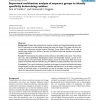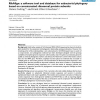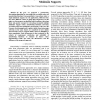376 search results - page 35 / 76 » Multiple Sequence Alignment using Fuzzy Logic |
BMCBI
2007
13 years 7 months ago
2007
Background: Proteins that evolve from a common ancestor can change functionality over time, and it is important to be able identify residues that cause this change. In this paper ...
BMCBI
2006
13 years 7 months ago
2006
Background: Until today, analysis of 16S ribosomal RNA (rRNA) sequences has been the de-facto gold standard for the assessment of phylogenetic relationships among prokaryotes. How...
FUZZIEEE
2007
IEEE
14 years 1 months ago
2007
IEEE
—In the past, we proposed a genetic-fuzzy data-mining algorithm for extracting both association rules and membership functions from quantitative transactions under a single minim...
FUZZIEEE
2007
IEEE
14 years 1 months ago
2007
IEEE
— DNA sequence basecalling is commonly regarded as a solved problem, despite significant error rates being reflected in inaccuracies in databases and genome annotations. This has...
RECOMB
2003
Springer
14 years 8 months ago
2003
Springer
We describe a novel method for detecting the domain structure of a protein from sequence information alone. The method is based on analyzing multiple sequence alignments that are ...



